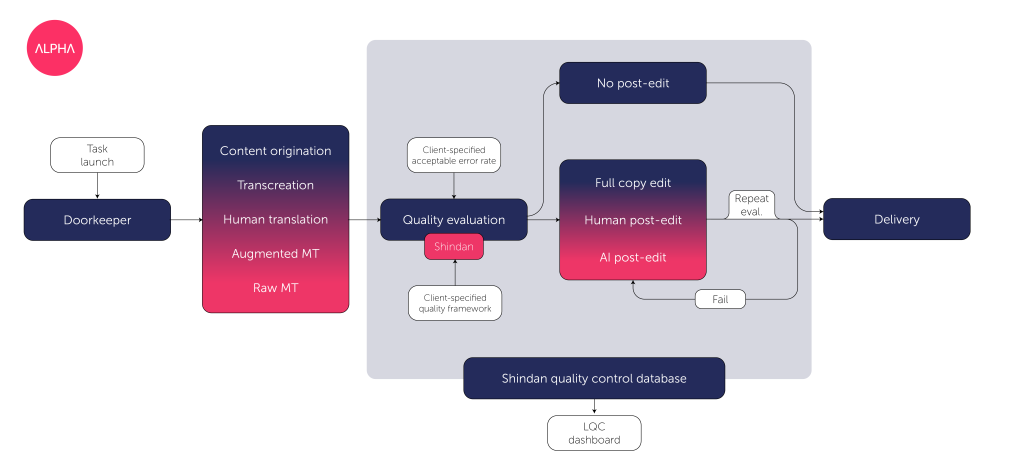
Since 1987, Alpha CRC has provided clients around the world with expert localization services. From humble beginnings in translation to full content creation and multilingual voiceover production, we’ve spent the last four decades honing our craft, working tirelessly to polish translation quality and help customers engage with their global audiences.
Now, almost forty years after we started, we’re taking a new leap into the future of localization. Introducing Shindan, our proprietary language quality management platform, designed to refine your localization workflows, optimizing your budgets so that you can take market penetration to a whole new level and localize more content than ever before.
Historically, translation projects have followed a linear process: the classic translation, editing, and proofreading (TEP). Over time, we’ve seen the arrival of alternative means of production – think machine translation paired with human post-editing (MTPE) – but the overall workflow has remained linear. Unless we were certain that raw MT was going to be acceptable, whole workflows adhered to the classic linear structure. That’s about to change.
As part of its suite of use cases, Shindan offers a comprehensive language quality evaluation solution that can help businesses to revolutionize their workflows through the power of AI. Built on an agentic AI network, Shindan uses intelligent parametric assessments to evaluate the quality of any given piece of bilingual content. Our ‘off-the-shelf’ solution has been designed largely in line with the ISO 5060 quality framework, but this can be customized to meet your specific needs.
This quality evaluation process will then be able to exclude certain strings, which are already deemed ‘high quality’, from the review or post-editing workflow. The result? Expert linguists only spend their time on the content that requires their cultural and linguistic expertise the most, reducing the cost per project and enabling more brand localization than ever before. All those help-desk articles that you’ve been wanting to translate but have never quite had the budget for? Suddenly, everything is possible.

Let’s take a closer look at the potential applications of Shindan on your projects. In the above example, you’ll see how a task moves straight from launch to translation. There are no restrictions on the type of translation performed here – ranging from fully human to neural machine translation (NMT) or large-language model (LLM). If you decide to opt for automated approaches to translation, we recommend using a service such as Braid, which will take your linguistic assets into account during the production process.
Once translation has been completed, the bilingual files are automatically reviewed by Shindan. Shindan does have an ‘off-the-shelf’ solution, in which it measures quality according to a generic understanding of expected output, but it can be customized using your localization assets to provide an even more accurate view of brand-alignment and translation quality through your specific lens.
Shindan assesses each piece of content across your chosen criteria, deciding which parts need to be sent for human review and which already meet your defined quality standard. Alpha’s localization experts are ready to help you define what quality means to your brand, which assets to use in customizing the tool, and to ensure all evaluation works for your specific needs.

During the evaluation process, Shindan uses an agentic AI network to ensure the highest possible quality output. Ken Chang, our Head of AI Development, explains why this agentic approach is key to Shindan’s success.
“Shindan’s agentic network has been designed to guardrail AI. Our design was inspired by the idea of a team of coherent members working together: while everyone has the same goal, they each have a different task to work on. The members share information and knowledge, but they ultimately each specialize in their own field, focusing on their own tasks. Shindan follows this model by incorporating multiple AI agents, each one focusing on a specific part of the language quality problem. Together, they create a full solution that can take into account style guides, terminology, and error categories to deliver a truly comprehensive language quality management tool.
This approach is vital because of the boost to consistency. When each agent is working on a small and focused task, the resulting output is significantly more consistent (and therefore reliable) than an AI that needs to deal with multiple tasks.
An agentic approach also helps to reduce AI hallucinations. When the assigned task is small, prompts can have a much clearer and more specific direction, and agents have much less info to process. This is what I’m referring to when I say that we’ve designed Shindan’s network to guardrail AI. We’ve also implemented a shared memory layer, which enables each agent to know what the others are working on. This enables the formation of an effective feedback loop, further enhancing the quality assessment.”

Where desired or necessary, Shindan can be configured to work with humans in a workflow. Content Shindan sends for further editing prior to delivery can be sent through human post-editing, or even AI post-editing, with potential for further review afterward. This can then create an editing loop in which content is continually tweaked until it meets your quality expectations for delivery. Here, we begin to see a more cyclical approach to the typical localization workflow.
While the above is an example of how we’d recommend using Shindan in your workflows, it’s important to remember that Shindan’s various capabilities can be ‘plugged in’ to various points of your production line.
When we were developing Shindan, one of our goals was to move beyond a task-based approach to quality, and instead enable businesses to garner deep insight into their long-term output quality across projects. As Shindan assesses each string or segment during the localization process, it stores this information in a centralized database, making it available through the language quality control dashboard.
As an increasing number of businesses switch to machine-translation-first workflows, accurate, ongoing quality control is only going to become more important. Here, you’ll be able to track output quality across language corridors over time, gaining insight into the typical errors that arise in each language pair, and begin troubleshooting as soon as you notice overall quality begin to drift.
Shindan’s powerful quality management tools can be deployed in various ways across your localization pipeline. Talk to us today to find out more about how it can benefit you.